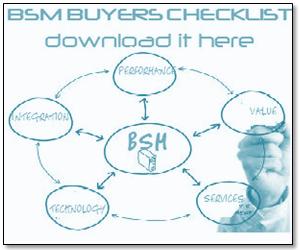
“Data, Data Everywhere — Not a BIT of Intelligence Anywhere”
What is Business Service Management simply and why does it appear to have waned in discussion and answer the question has it failed, is the concept required, what’s new? Yes, the number one complaint in the market is still that IT does not understand the business, the level of frustration is rising and fuels the fire driving cloud computing and hosted services.
Business can buy easily, don’t hear about operational processes, technology and why things don’t work. They hear a service, price and value delivered. So what is BSM and why did it fail and why is it still the fuel driving the outsourced market.
It is really quite simple, it became an marketecture umbrella for many over a large collection of tools focused on silos of management capabilities, ITIL tools and processes. I recently had the privilege to discuss the topic with my friend Jean-Pierre Garbani of Forrester Research and his recent article: I&O Execs: It’s Time to Rediscover BSM JP summed it up well in the opening, “BSM today has morphed into an Information Technology Infrastructure Library (ITIL) support solution,;rather than the pure infrastructure and application management vision that appeared seven years ago.”
As I reviewed many RFPs and spoke to many organizations during this era, the executive overview is always about connecting to the business and the need to manage IT in lock step with the business, but the requirements reviewed and projects are always the same: ITIL incident, problem, change, configuration, asset management and generally service desk technology.
The second most popular technology during this era were the discovery tools that held the promise of mapping logical services out of physical infrastructure. What was quickly discovered is that it was a lot like drinking water from a fire hose. Tons of data that needed to be reconciled and for what purpose: business service logical mapping or technology configurations for the tuning and management of the physical infrastructure. What was difficult and could not be addressed auto magically with a discovery tool is the logical connection to business services.
So once again the concept is spot on, the implementation goes straight back to an operational focus – what IT knows. However the answer stares us in the face, we have tons of “data”, what we need is intelligent information by which to take the appropriate action at the right time. “Data, Data Everywhere –> Not a BIT of Intelligence Anywhere”. Many tools provide a wealth of fantastic data – performance, availability, configuration, process records (changes, incidents, problems), etc. by which to tune the technology, but it is the aggregation of all this data that transforms the data into intelligent information. There is no one magical tool that will deliver Business Service Management, it is a mindset and the transformation of the data when it will begin to speak to you as service information.
In one article, there were some recent survey results the author found shocking. What I find shocking is that after 20 years IT is still making a grade of a D+. We are in the midst of the usual circle that hinders recognizing the “B” of BSM – the Business. A focus on new technology for what is perceived as cost savings by acquiring technology on demand and not managing the hardware and software to operate the service. However, in the long run without strategy and management focusing on business objectives, what appears cheaper will have higher long term costs. Why are cloud based services and service provider offerings so popular? Under the veneer of the agility it brings organizations is the frustration business has with their technology organization. It is the failure of IT being exposed and outsourced.
Survey results continue to illustrate the number one global concern as the lack of understanding business and the priority and impact of technology on the business. The number one reason cited for lack of ITIL adoption/success was lack of management commitment. Those 2 citings alone speak volumes to me. I ask why there should be a focus on ITIL and why the number one focus isn’t driving business growth? This upside down focus is the fiery failure of the marketecture of first generation BSM.
Why aren’t we talking more about new and unique services driving business growth? Business moving to the cloud removes the requirement for operationally focused projects (ITIL) that have not delivered business value. In a recent Harvard Business Review survey, an observation was noted that the role of IT is shifting from “constructing and operating” to that of “acquiring and deploying”. I’m not so sure I agree that it is so much about deploying as it is about “service managing” and management of the suppliers. This will require very different skills and the transformation of roles within IT and will force the focus on the Business value.
The time has come for the Business Service Management imperative and Transforming Data into Intelligent Information focusing on driving business value. This does not require more monitoring tools and IT processes as much as it requires the following:
- Service Identification, Classification, Business Prioritization (see previous post)
- Integration and Aggregation of Data Sources
- Service Mapping based upon Data Sources
- Service Rules Weighting Data and Thresholding Data
- Service Visualization
- Service Trending Over Time
- Service Intelligence in Real Time
IT organizations already have a wealth of data from their multitude of management tools. While I often hear, “we don’t know what our services are or we cannot map our services”. Generally, the data from several data sources currently in place can get to a 70% + service view with an aggregating, reconciling and visualizing approach and technology transforming the wealth of data into intelligent information. What is the value of this Transforming Visualizer of Intelligent Information or rather what is the cost of not having the Transforming Visualizer:
- A single service impacting event costs your organization 1-2% of revenue
- 85% of the time IT is Bulb Monitoring and reacting costing your organization 1-2% of revenue annually, every year
- >80% of service impacting events are caused by poor process, lack of impact visibility and business correlation
Millions of dollars are spent annually maintaining, bulb monitoring and reacting. What if just 25% of what is currently spent is applied to the Transforming Visualizer? A 75% cost savings and the ability to monitoring revenue growth instead. This is what I still find shocking as I continue to read and speak about the same D+ grade after 20+ years.
The environment is getting more complex, the roles are being forced to change with the outsourcing of operations to the cloud and the requirement to drive business growth is an imperative today more than ever. The Perfect Storm of technology, service providers and business requirements to drive service value is in full force.
As JP points out in his recent paper, availability of services and the proactive service impact knowledge in controlling change in the environment both require the connection to business priority and objectives and plainly, knowing your services. I had the opportunity to speak with Thomas Mendel, previously of Forrester research on just these two topics in these two podcasts: BSM in the Cloud: Managing and End-to-End View Made Simple and BSM in the Cloud: Configuration Complexity Made Simple.
BSM is an imperative and will transform in focus to the aggregation of data, making the connection to the business to manage with priority in mind both for availability of services and the compliance of change to services in controlling the infrastructure. Transform your data into Intelligent Information with a business focus and a BSM 2.0 approach.
Business Service Management – Imperative or Not?
Michele














